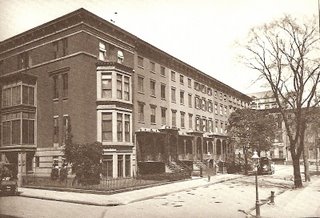
The beautiful historic neighborhood known as Gramercy Park, located between 18th and 22nd Streets to the South and North, and Third and Park Avenues to the East and West, was once a swampland. An astute lawyer-turned real estate investor named Samuel Ruggles, nevertheless understood the value of Manhattan real estate when he bought the land in 1831. Ruggles had previously invested in the Erie Canal, and had bought and cultivated numerous vacant lots to become Union and Madison Squares. In 1831, a small brook named the Crommessje, Dutch for "little crooked knife," traversed the swamp. Ruggles drained the swamp and planted trees and flowers throughout the space, creating an enticing respite from the bustle of city life downtown. He then divided the land around the park into lots specifically designated for the building of private residences. Ironically, Ruggles wanted to develop the area to imitate a London square, modelling it after St. John's Park (see archived posting), and the pronunciation and spelling of Crommessje became what we today know as Gramercy, which sounds English! Ruggles hoped to draw New-York residents north to his quiet park by providing in the land deeds that the park itself remain locked and only those who purchased lots would be provided with keys. Foreseeing the northern development of the City, Ruggles created a new north-south avenue, named Lexington above the park after the Revolutionary Battle, and Irving Place below it in honor of the writer Washington Irving.
Many well-known people have inhabited Gramercy Park, including actor Edwin Booth, a sculpture of whose likeness stands in the middle of the park, NY Governor and Presidential candidate Samuel Tilden, NYC Mayor James Harper, founder of Harper & Brothers publishers, architect Stanford White, and William Sydney Porter, better known as the storyteller, O. Henry.
Photo: Gramercy Park West, facing south, New-York Historical Society.
Reference: Klein, Carole. "Gramercy Park: An American Bloomsbury," Baltimore: The Johns Hopkins University Press, 1987.
No comments:
Post a Comment